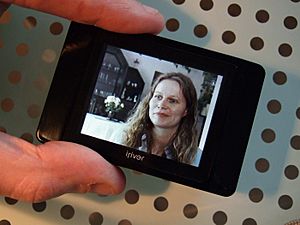Digital multimedia broadcasting facts for kids

Digital Multimedia Broadcasting (DMB) is a special way to send TV, radio, and other information to mobile devices like mobile phones, laptops, and GPS systems. Think of it as "mobile TV" that you can watch on the go!
This technology was created in South Korea as a big national project. It was meant to be the next step after FM radio. However, some of the main ideas for DMB came from researchers in Germany. The world's first official mobile TV service using DMB started in South Korea in May 2005.
DMB can work in two main ways:
- S-DMB (Satellite DMB): This uses communications satellites to send signals.
- T-DMB (Terrestrial DMB): This uses signals sent from towers on the ground, similar to how regular TV or radio works.
DMB is different from Digital Audio Broadcasting (DAB), which is mainly for radio.
Contents
How T-DMB Works
T-DMB sends signals from towers on the ground. It uses special technologies to make sure the video and audio look and sound good on your mobile device. For example, it uses MPEG-4 Part 10 for video and HE-AAC v2 for audio. These are ways to compress and send video and sound efficiently.
The signals are designed to work well even when you are moving, like in a car. This makes it great for watching TV or listening to radio on the go. In 2007, T-DMB was officially approved as a global standard, along with other mobile TV systems like DVB-H and 1seg.
Smart DMB
Smart DMB was launched in South Korea in January 2013. It made mobile TV even better!
- It added a VOD service, which means you could choose what to watch, not just what was currently broadcasting.
- The picture quality was improved from 240p to 480p, making it clearer.
Many smartphones in South Korea, like the Galaxy Grand, started to have Smart DMB built right in.
HD DMB
HD DMB is an even newer version that started in South Korea in August 2016.
- It improved the picture quality a lot, from 240p to 720p. This is called High Definition (HD).
- It uses a newer technology called HEVC.5 codec for better video.
Some smartphones with powerful processors could get a software update to support HD DMB.
Countries Using DMB
While DMB was developed in South Korea and is used a lot there, some other countries have also tried it out.
South Korea
South Korea was the first country to launch DMB services.
- S-DMB started in May 2005, and T-DMB started in December 2005.
- By 2006, T-DMB in South Korea offered 7 TV channels, 12 radio channels, and 8 data channels for free.
- S-DMB, which uses satellites, is a paid service and works across the whole country.
- T-DMB is free but only available in certain areas.
Millions of DMB receivers have been sold in South Korea, and many new cell phones there have DMB built-in. You can find DMB in car navigation systems, mobile phones, and portable media players.
Other Countries
Some other countries have tested or used DMB:
- Norway: Had T-DMB services from 2009 to 2018.
- Germany: Launched a T-DMB service called "Watcha" in 2006, but it stopped in 2008.
- France: Chose T-DMB for digital radio in 2007, but later switched to DAB+.
- China: Has had DAB and T-DMB services in several cities since 2007.
- Mexico: Many cell phone companies offered DMB broadcasting as part of their plans.
- Ghana: Started a T-DMB service in Accra and Kumasi in 2008.
- Indonesia: Is running trials in Jakarta.
- Italy and Vatican City: Are running trials in some areas.
- Canada: Has been running trials since 2006 in cities like Ottawa and Toronto.
- Malaysia: Has been running trials since 2008.
- Cambodia: Chose T-DMB as its national standard for digital broadcasting in 2010.
DMB in Cars
DMB works very well in cars, even when traveling at high speeds (up to 300 km/h or about 186 mph!). Even in tunnels or underground areas, you can often still get DMB signals, though they might skip sometimes. In South Korea, some long-distance buses use T-DMB instead of satellite TV because it works so reliably.
Images for kids
-
Live DMB broadcast on an iriver device during trials in Munich, Germany (2007)
See also
 In Spanish: Digital Multimedia Broadcasting para niños
In Spanish: Digital Multimedia Broadcasting para niños
- 1seg
- Digital Audio Broadcasting (DAB)
- Digital Video Broadcasting (DVB)
- DVB-H
- Mobile TV
- Satellite radio
- Satellite television




